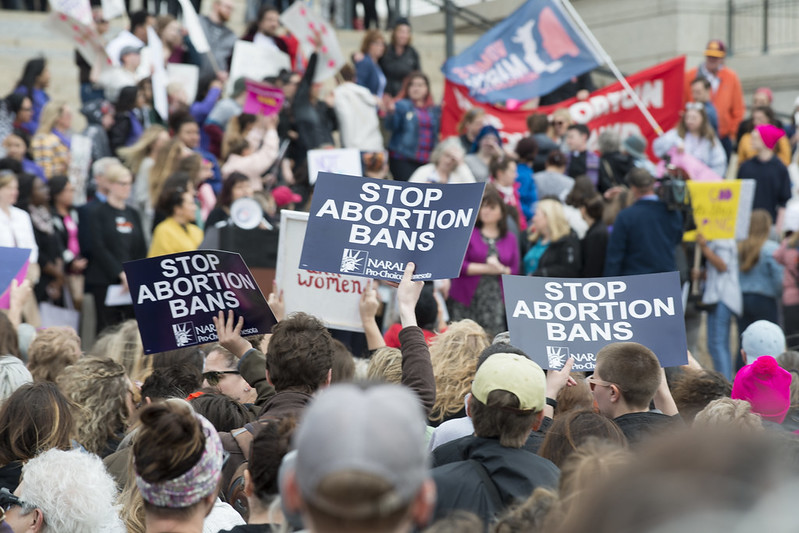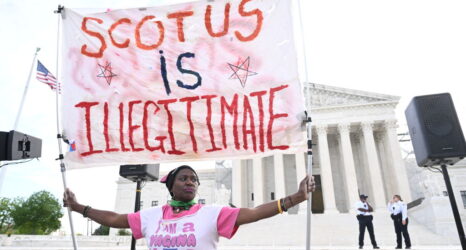“There is a mountain of pressing issues that state legislators need to deal with. … But none of that really gins up the conservative base. Instead, we are seeing attacks on trans youth, attacks on abortion, and attacks on voting rights.”
—Elizabeth Nash, Guttmacher’s principal policy associate on state issues.

Editor’s note: The laws discussed in this piece are not yet in effect and will likely be challenged and blocked before making their way to the Supreme Court.
In the first four months of 2021, anti-abortion lawmakers introduced 536 abortion restrictions in 46 states, including 146 abortion bans, according to a report released by the Guttmacher Institute on Friday. They enacted 61 restrictions in 13 states, including eight bans that would go into effect if the Supreme Court overturns Roe v. Wade. Governors signed 28 restrictions into law in eight states just last week.
“Each additional restriction increases patients’ logistical, financial and legal barriers to care, especially where entire clusters of states are hostile to abortion,” said one of the report’s authors Elizabeth Nash, Guttmacher’s principal policy associate on state issues.
Anti-abortion lawmakers have passed significantly more abortion restrictions in 2021 than in the first four months of 2011—the year previously regarded as the most hostile to abortion rights since Roe—when states enacted 42 restrictions by the end of April, including six bans.
Here’s a sampling of some of these recent laws attacking abortion access:
- Arizona passed a bill to criminalize providers who perform or aid in an abortion sought due to a fetal genetic abnormality.
- Arkansas passed a bill requiring patients to view an ultrasound before an abortion.
- Indiana and West Virginia passed bills requiring abortion providers to inform patients about “abortion reversal,” which is not supported by medical evidence.
- Kentucky passed a bill to remove the right to an abortion from the State Constitution.
- Oklahoma passed a law adding abortion procedures to the list of unprofessional conduct by doctors and a “heartbeat bill” prohibiting abortions if a fetal heartbeat can be detected.
- South Dakota passed a bill to ban abortions based on a fetal Down syndrome diagnosis.
- Wyoming enacted a “born-alive” bill, which will take effect July 1.
A Blip, or a Sign of More to Come?
Nash believes this surge is not a coincidence, but a harbinger of more restrictions in the coming months.
“It doesn’t look like anything is abating for the foreseeable future,” Nash told Ms. “We haven’t even gotten to Texas, which is coming out with a whole package of restrictions on abortion that includes everything from a near total ban all the way to restrictions on medication abortion. Texas has one of these legislatures that shifted further to the right in the past election and we’re seeing this whole smorgasbord of abortion restrictions there. It reminds us again just how important state legislatures are and who’s in them.”
Bills like these fly in the face of health experts. On Tuesday, 200 physicians signed and sent an open letter to members of the Texas House expressing their opposition to one such bill: Senate Bill 8, which would ban abortion after just six weeks and would allow “any person” to sue doctors who perform abortions, and will be considered by the full House on Wednesday.
Several other states are poised to adopt new restrictions too, said Nash—including Montana, Florida, Oklahoma, Idaho, Tennessee and Missouri.
Why Now?
Nash attributes the surge to several factors. “One, the 2020 elections resulted in a number of state legislatures becoming more conservative in places like Texas, Arizona, South Carolina, Montana and Wyoming. But also, we have a Supreme Court that has announced that they are welcoming more cases on abortion,” referring to Chief Justice Roberts’s concurrence in last summer’s abortion decision of June Medical Services v. Russo. “This is creating an environment where state legislators are eager to move abortion restrictions.”
Sadly, in a new report released by our members over at @Guttmacher, 2021 is shaping up to be the worst year for abortion legislation in decades. More than 500 restrictions have been introduced across 46 states, 61 of which have already been signed into law. #StopTheBans https://t.co/AT70KGvlvW
— NAF (@NatAbortionFed) April 30, 2021
But Nash also emphasizes how conservative legislators are using the issue of abortion to mobilize their base, as they did in a previous surge in abortion restrictions.
“Back in 2011, the United States was coming out of a recession, but state legislatures still had heavy revenue issues and there was a lot of unemployment. In the 2010 elections, we had a real shift to more conservative legislators in part because these candidates were saying that they wanted to do something about the economy and do something about state budgets. But instead of addressing these economic issues, they focused on social issues—in particular, abortion. They did that because they were looking to solidify their base and keep their base engaged.”
“We are seeing some of the same things happen in 2021,” said Nash. “There is a mountain of pressing issues that state legislators need to deal with. There’s health care access in the pandemic, there’s systemic racism, there’s education reform and criminal justice reform, unemployment, small business assistance—the list goes on. But none of that really gins up the conservative base. Instead, we are seeing attacks on trans youth, attacks on abortion, and attacks on voting rights.”
In the first four months of 2021, Republican lawmakers introduced 360 bills to restrict voting rights and over 100 anti-transgender rights bills.
Restricting Abortion and Challenging Roe
“The abortion restrictions are designed to further limit access to care right now, but they are also designed to start a court case with the goal of weakening our abortion rights at the federal level,” said Nash. The Supreme Court now has a 6–3 conservative supermajority established by Trump’s appointment of three anti-abortion lawyers to the court.
When abortion rights groups challenge restrictive laws, states are fighting to uphold them with hopes of reaching the Supreme Court. For example, Tennessee asked the Supreme Court to reimpose its law requiring a 48-hour waiting period for abortions after lower courts found it unconstitutional. Kentucky Attorney General Daniel Cameron recently filed a brief along with 21 other Republican attorneys general in support of Tennessee.
For several months, the Supreme Court has been considering whether to hear a case—Dobbs v. Jackson Women’s Health Organization—involving the constitutionality of a Mississippi law that bans all abortions over 15 weeks of pregnancy with narrow exceptions (the lower courts struck down the ban).
“It appears that the court isn’t particularly interested in this case,” said Nash. “It seems like the court, at least at this point, is looking for a different kind of abortion case—a restriction of some kind that would allow them to start to undo the protections that we have by expanding the types of restrictions that are permissible, and then you could see additional cases coming down the pike that get more into the actual right itself.”
Earlier this year, the court upheld a Trump administration policy blocking access to the abortion pill by mail, a policy the Biden administration later reversed. Another issue ripe for Supreme Court review is banning abortion for fetal anomalies—known as a “reasons ban”—because lower courts have issued conflicting rulings on the constitutionality of these bans.
The onslaught of anti-abortion laws is straining the capacity of feminist lawyers to challenge these restrictions, said Nash. “It’s a huge undertaking to bring a court case. It takes a lot of research, a lot of strategy, a lot of attorneys, and a lot of money. There’s simply not enough attorneys to go around. There are a number of restrictions that are unconstitutional based on current Supreme Court rulings that are in effect because there are other more pressing cases that had to be brought and not enough attorneys. Also, finding plaintiffs who can withstand a court case is really hard,” added Nash.
In the past week, 28 new anti-abortion restrictions were signed into law in 7 states — the highest in a single week of the past decade.
— Pramila Jayapal (@PramilaJayapal) May 3, 2021
Having an abortion isn’t an easy choice, but it should be exactly that: a choice.https://t.co/hmuOur311N
Nevertheless, abortion rights supporters have succeeded in getting courts to block some of the recent anti-abortion laws. For example, a Kansas court blocked the state’s ban on a standard, second-trimester abortion procedure. A judge in Ohio temporarily blocked the state law requiring fetal remains to be buried or cremated. Another Ohio law banning telemedicine abortion was temporarily blocked after a judge filed a preliminary injunction in response to Planned Parenthood’s lawsuit.
Hopes for Strengthening Abortion Rights
While conservative states are restricting abortion, some progressive states are expanding abortion rights. For example, in New Mexico in February, Gov. Michelle Lujan Grisham (D) approved a measure that repeals the state’s pre-Roe abortion restrictions. And Hawaii’s governor signed a bill allowing some nurses to provide abortions, addressing a doctor shortage that forced people seeking abortions to fly to Honolulu to obtain care. Virginia adopted a law expanding coverage of abortion in private insurance plans.
Many abortion rights supporters see Congress as key to strengthening abortion rights. Three proposed laws offer hope:
- The Women’s Health Protection Act would establish federal statutory rights to abortion for providers and patients and shield them from state-level restrictions, like pre-viability bans; mandatory medical procedures, such as an ultrasound; medically inaccurate counseling; medication abortion restrictions; targeted regulation of abortion providers (TRAP) laws; and in-person visit requirements.
- The Equal Access to Abortion Coverage in Health Insurance (EACH) Act would reverse the Hyde Amendment.
- The Abortion is Health Care Everywhere Act would permanently end the Helms Amendment.
But with an even split in the Senate and the filibuster rule in place, which requires 60 votes to move a bill to the floor, these laws will only pass if the U.S. Senate ends the filibuster.
Meanwhile the Biden administration is quietly lifting abortion-related restrictions in federal government. In April, Biden lifted the Trump administration’s ban on federal funding for research that uses fetal tissue from abortions and lifted an FDA ban on dispensing medication abortion by mail. His administration also proposed changes that would reverse the Trump administration’s domestic gag rule, banning Title X funding for organizations that provide or make referrals for abortions.
Despite these gains, abortion rights are under dire threat.
“The current barrage of coordinated attacks must be taken seriously as the unprecedented threat to reproductive health care and rights that it is,” concludes the Guttmacher report. “The year 2021 is well on its way to being a defining one in abortion rights history.”
You may also like:





